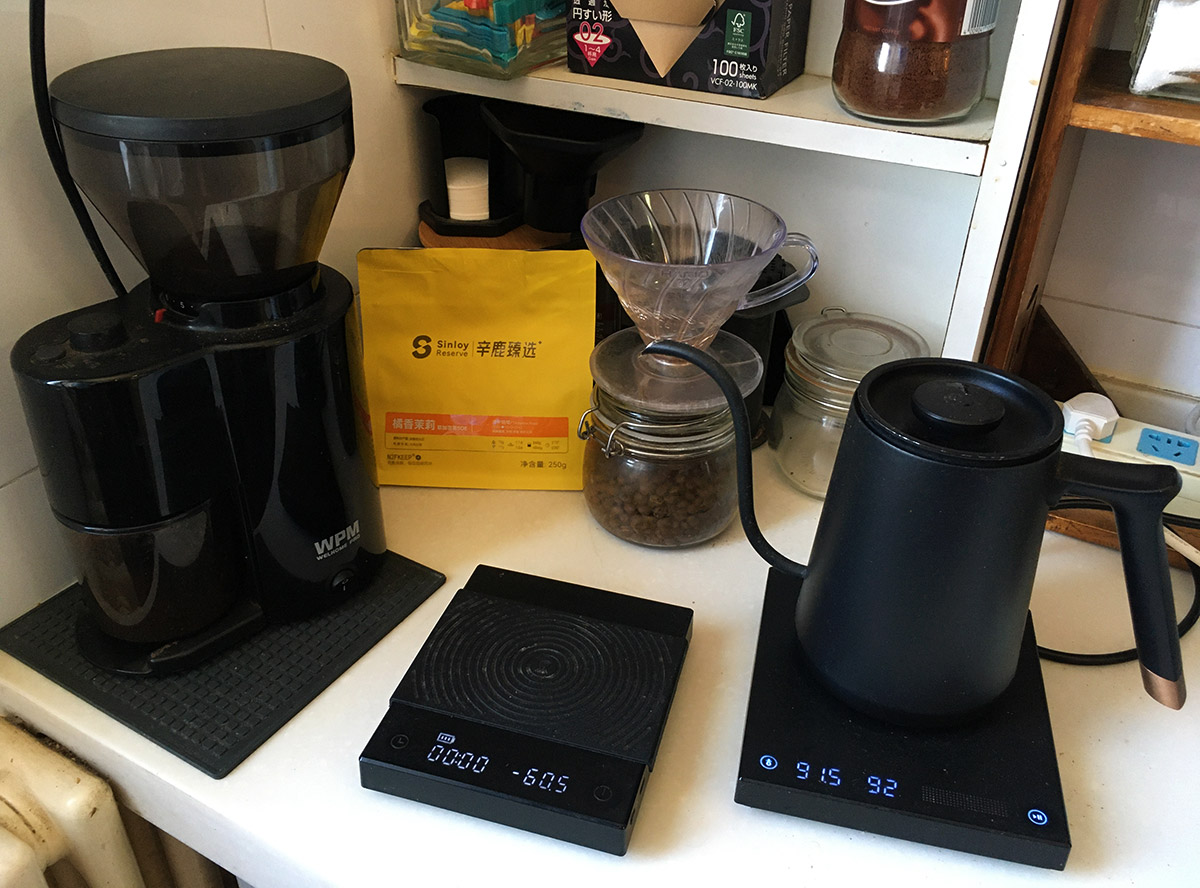Commentary on James Hoffman’s “Ultimate V60 technique” for pour-over coffee
I’ve made more than 400 cups of coffee using the “Ultimate V60 technique”, and here are some notes about using that method to make a café-quality cup of coffee at home.
This is a commentary, not a critique, and it’s mostly notes on what I learned about making pour-over coffee using this technique, with observations on some of the details. Maybe not the post for you if you’re looking for deep insights on coffee, in which case you should check out Mr Hoffman’s Youtube channel instead.
I wanted to learn how to make a fancy coffee shop type cup of coffee at home without having to buy a full-on espresso machine, and following the method in this video was how I did it.
After getting the grind size and water temperature dialled in for the beans, this technique does indeed produce a tasty cup of coffee. Much appreciation to Mr Hoffman.
It did take a few tries (*ahem*, yes, “a few”) to figure it out, and I had to endure some self-inflicted terrible coffee while doing that. But now I’ve got it going pretty good. It’s hard to judge if I am actually getting a fancy-café-quality cup of pour-over coffee out of it, but … I think I do?
Here’s the video, titled “The Ultimate V60 Technique”.
And here are some notes/comments/observations on the main things mentioned in the video.
Coffee to water ratio
I’m doing one cup at a time, with 15g of coffee to 250g of water. (1:16.6777 ratio)
Grind size
The coarseness (or fineness) of the grind is one of the variables involved.
With a coarse grind, the water goes through more quickly. With a finer grind, the water goes through more slowly.
In general, the darker the roast, the coarser the grind used.
For dark roasts: somewhere between 7 and 8 on my grinder.
For light roasts: between 6 and 7 on the grinder.
For super light roasts: between 5 and 6.
Water temperature
The temperature of the water is another of the variables involved in the eventual taste of the coffee.
The temperature affects how fast the water goes through the coffee. Hotter water goes through more quickly. Cooler water goes through more slowly.
I’ve settled on 92°C. I don’t have it ‘hot as possible’ as mentioned in the video—haven’t had good tasting coffee that way.
Rinsing the filter paper
I just pour a bit from the kettle after it’s heated to 92°C, and use just enough water to wet the filter. I’ve tried using larger amounts of hot water to warm up the V60 and the cup, but it made no noticeable difference for me. The water should be poured into the center of the filter first, which then pushes the filter down into the V60 and makes the filter fit smoothly.
Bloom
I use twice the amount of water as there is coffee to do the bloom, the same as recommended in the video. With 15g of coffee, that’s 30g of water. I also swirl it all around until the grounds are all soaked. I try to keep to 45s total time for the bloom so that the water in the kettle doesn’t cool down too much in the meantime.
As part of the bloom process you should see bubbles or steam. Darker roasts tend to bubble a lot. (The bubbles and steam are supposed to be carbon-dioxide gas being released from the beans.)
Pour timing
I’m making a cup with 250g of water, so my timing ends up like this.
| 0–8s | Add 30g of water for the bloom |
|---|---|
| 8–45s | Swirl it around until well mixed, then wait |
| 45s–1m15s | Pour water at a rate that gets it to 150g by 1m15s |
| 1m15s–1m45s | Pour water at a rate that gets it to 250g by 1m45s |
| And then… | Shake it a bit to settle the grounds and wait til it all drips through |
My understanding of the timing is that you pour the first part a bit more quickly so that the coffee grounds are swirling around in the water sooner and more water is touching more grounds for the extraction. The last part is poured a bit more slowly to extend the extraction time. The water is not poured in all at once because the water might then come in direct contact with the filter paper.
“Don’t let the water touch the filter paper”
My understanding of this part is that you want the water to go through coffee grounds before it hits the filter, so you don’t get non-coffee-flavoured water dripping down the sides of the V60 and into the cup.
Where I’m pouring the water
With the above in mind, I’m pouring water in a small circle in the middle of the grounds until that water pushes some of the coffee grounds out to the sides of the V60. After that I’m pouring spirals in and out from the center ‘to agitate the coffee grounds and extract more taste’.
Shaking it a bit to settle the grounds
I guess settling the bed of the grounds means that more water goes through more coffee. I do this because Mr Hoffman says so.
Dialling it in
I like to experiment with fancy/weirdo beans and it sometimes takes a couple of tries to figure out how to get it tasting good.
I (try) to get it dialled in by adjusting the grind while keeping the temperature at 92°C.
If the coffee is bitter (and it’s not supposed to be) I use a coarser grind on the next try. My assumption here is that the water didn’t go through fast enough and I’ve over-extracted it. A water temperature that is too high also seems to produce unpleasantly bitter coffee.
If the coffee comes out sour I try a finer grind on the next attempt. My assumption here is that the water went through too fast and I’ve under-extracted it. A water temperature that is too low will produce sour coffee.
If the coffee seems too weak I grind it finer on the next try, assuming that the water went through too quickly.
In general?
In the video he’s using this technique to make enough coffee for two cups.
By following along I think I’ve learned how to make a good tasting fancy-coffee-shop-style single cup pour-over.
Two independent reviewers (HJ, JW) agree with me and are repeat coffee customers.
The obligatory gear shot

Sponsor-presented message:
This post is brought to you by Colacola Cola©. Colacola Cola … use your brain to imagine the best-tasting Cola Drink you’ve ever tasted … and then add Colacola. Colacola Cola … now that’s Colacola!
